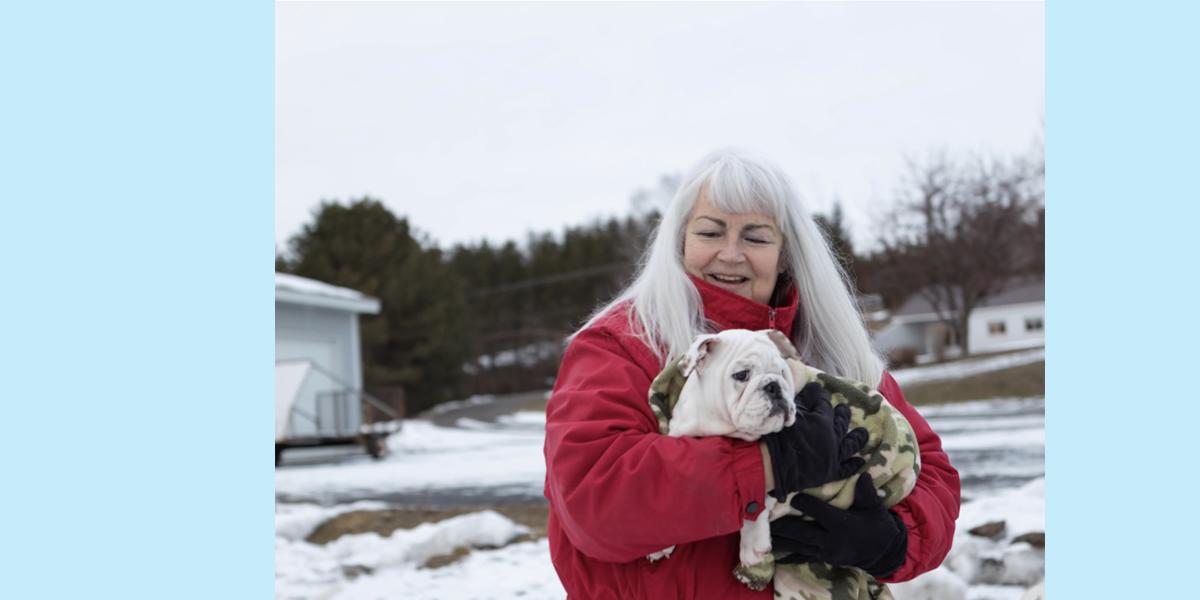Steadfast dedication
How a ground-breaking procedure in one bulldog has saved the lives of three other dogs.

How a ground-breaking procedure in one bulldog has saved the lives of three other dogs.
Merle Peterson holds a 6-month-old Vivian. Photo courtesy of Merle Peterson.
Merle Peterson has always had at least one English Bulldog her entire adult life. At times, she had as many as three, but Vivian Elizabeth, her 1.5-year-old white bulldog has always been special.
Vivian was the only one in her litter whose coat was pure white—just like Peterson’s first pet bulldog was 40 years ago.
But in August, just shy of her first birthday, Vivian started occasionally struggling to digest her meals. When she began to vomit after every meal, just days after her first symptoms started, Peterson knew something was wrong.
“She’s a voracious eater but she couldn’t even keep water down,” she recalls.
Peterson, who lives in Cloquet, Minn., took Vivian to a clinic in Duluth, but the small clinic didn’t have the equipment they needed to look at the pup’s esophagus, which they suspected may hold the key to what was making Vivian sick. They recommended Peterson take her beloved pet 150 miles south, to the University of Minnesota (UMN).
So, Peterson did just that. It was a decision that saved Vivian’s life—and brought a groundbreaking treatment to the UMN Veterinary Medical Center (VMC).
Dr. Briana Neuzil, a resident of Small Animal Internal Medicine at the VMC, was part of the team of veterinarians that diagnosed Vivian with an esophageal stricture. The esophagus is a tube in dogs’— and humans’—throats that contracts when they swallow, moving food and liquids into the stomach. The build-up of scar tissue in Vivian’s esophagus—the stricture—was causing part of the tube to kink, keeping her from swallowing and being able to move food and water into her stomach.
In the first year and a half of her life, Vivian underwent five procedures to dilate her esophagus with an esophageal balloon dilation device. When Vivian was under anesthesia, Neuzil inserted a deflated balloon down her throat. Slowly, she’d inflate the balloon with water, breaking up the scar tissue and allowing her esophagus to expand.
“In most dogs, we do this one or two times and they’re fine. But that wasn’t the case with Vivian. She would go home and be able to eat like normal for a couple of days, but then the stricture would reform,” Neuzil says.
Vivian lost 10 pounds and her condition made her coat fall out. Since she couldn’t swallow, she had a feeding tube. The experience was hard on Peterson, too. Between September and Thanksgiving, she made the trip from Cloquet to St. Paul and back 20 times.
“I thought, ‘I can’t do this anymore.’ I was exhausted, Vivian was exhausted. She was quite a sight and I was scared of the way things were going,” Peterson recalls.
After Vivian began to regurgitate her food after her fourth procedure, the VMC team started pursuing a new procedure that was only being performed by a few veterinarians—one being the doctor in New York City who developed the technique.
After several consultations with the doctor in New York and many calls to trace down the right equipment, Neuzil’s team was ready to propose the idea to Peterson. The procedure—called a balloon esophagostomy (BE) tube—would place a feeding tube with an attached deflated balloon into Vivian’s esophagus. But this time, it would stay there for six weeks and would need to be inflated twice a day using an air pump that would sit on the outside of Vivian’s throat. If it worked, the consistent inflation would keep the stricture from reforming and closing her esophagus.
“Dr. Neuzil said, ‘I can’t give up on your dog. She’s young and spunky and she wants to come through this. We have to figure out a way to help her,” Peterson remembers.
The two decided that Vivian would spend six weeks living with Neuzil, who would go above and beyond the call of duty to become the bulldog’s full-time caretaker
“It’s the first time I’ve experienced a doctor who cared about Vivian as much as I do,” Peterson says.
The following weeks were some of the hardest of Neuzil’s life, but the constant care and early mornings were worth it—the BE tube was successful. Not only is Vivian back to her old self, but the VMC also has used the BE tube procedure in three other dogs. It’s a huge step forward that ultimately made the VMC one of the only hospitals in the country to do the procedure.
“It’s hard to talk about,” Peterson says. “I was afraid I would lose her, and Dr. Neuzil and the University saved her life. They didn’t give up on her.”